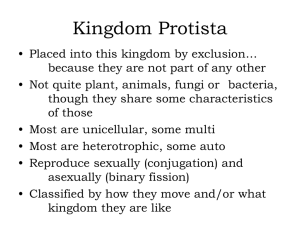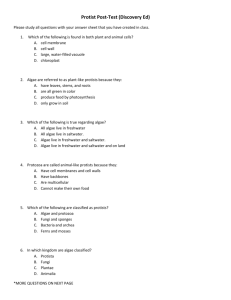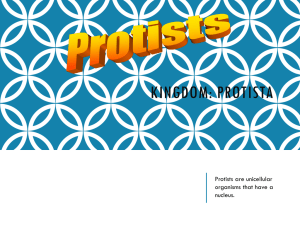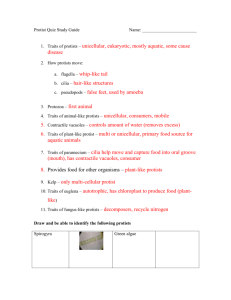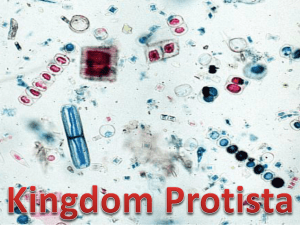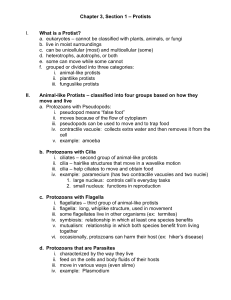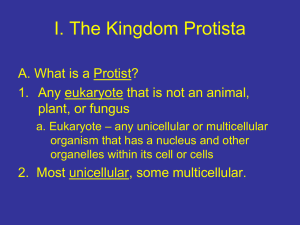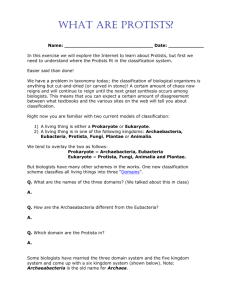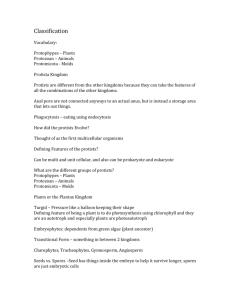Kingdom Protista
advertisement
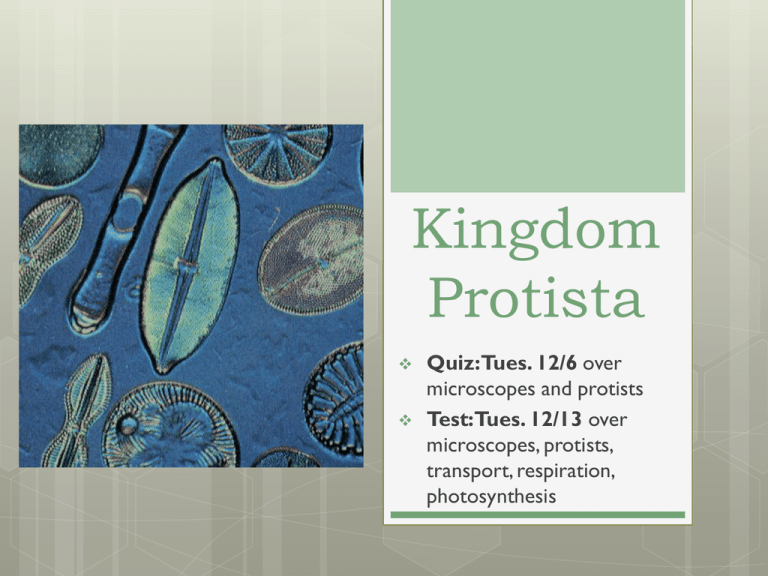
Kingdom Protista Quiz:Tues. 12/6 over microscopes and protists Test:Tues. 12/13 over microscopes, protists, transport, respiration, photosynthesis Classification of Protists Kingdom with the most diverse members Unicellular and multicellular Heterotrophs, autotrophs, or both Various types of cell walls Are all Eukaryotes!! (nucleus!) Classifydo bywe how they obtain So…how classify them?? nutrition Animal Plant Like—Heterotrophs Like—Autotrophs Amoeba Fungus Like—Decomposer, Parasites This classification system does not explain evolutionary relationships and will probably change in the future. Also classified by how they move Some use pseudopods (false feet) Some use flagella (like a whip) Some use cilia (tiny hair like structures) Some don’t move at all This classification system does not explain evolutionary relationships and will probably change in the future. Amoeba Movement Video Animal-Like Protists Amoeba and Entamoeba Pseudopods are temporary projections of cytoplasm (false feet) Animal-Like Protists Flagellates: Have flagella-whip like structure that aid in movement EX: Triconympha—lives in the gut of termites and helps digest wood Trypanosomas—African sleeping sickness caused by bite of a Tsetse fly Animal-Like Protists Ciliates: Move with cilia Hair-like projections used for moving and catching food EX: Paramecium Gullet for food intake Contractile Vacuole—used to pump out excess water from the cell Animal-Like Protists Phylum Sporozoans—parasitic protists Nonmotile—do not move EX: Plasmodium—causes Malaria, carried by Anopheles mosquito http://www.youtube.com/ watch?v=8GPn9rqg_HA Ecology of Animal-Like Protists Why Live are they important?? symbiotically with other organism (termites gut) Live in lakes/oceans, bottom of marine food chain (zooplankton) Recycle nutrients/make organic matter Plant-Like Protists—Algae Unicellular and multicellular Autotrophs Produce most of the worlds oxygen Use chlorophyll and accessory pigments to collect light Unicellular Algae—Diatoms Glass-like cell walls made of silica Forms diatomaceous soil when they die and sink to the ocean floor. Uses: Filter ponds Abrasive in cleaners Brightener in paints Kills pests (slices exoskeleton) Diatoms Unicellular Algae—Euglena Has 2 flagella Contractile vacuole— pumps out excess water to maintain homeostasis Pellicle—Cell wall Eye spots—detect light Both heterotrophic and autotrophic (plant and animal like) Euglena Multicellular Algae Volvox: colonial algae Red Algaeused to make agar Pond scum Brown Algae: Sea Kelp Diseases… Giardia - causes humans to become sick when drink water with cyst Gonyaulax - produces toxins that paralyze and kill (red tide) Potato blight - threatened crops in Ireland, potato famine 1846 Toxoplasmosis- found in cat feces, can be fatal to developing fetus Videos Pond water video—good amoeba and euglena http://www.youtube.com/watch?v=kB6vgZi99gw Amoeba eating—good to look at after talking about active transport http://www.youtube.com/watch?v=ojrkxmD6tT8& feature=related Cellular Processes of Protists Active Transport Moves substances against concentration gradient Move from HIGH to LOW conc. Bulk Transport Endocytosis (a) – in to cell Phagocytosis movement of large solid molecules into the cell Pinocytosis is the ingestion of extracellular fluid Exocytosis moves large molecules out of cell (b) Ex: proteins, waste Click Picture for Video Passive or Active? Passive(no ATP) Simple diffusion Osmosis Facilitated diffusion High Low Active(requires ATP) Endocytosis Phagocytosis Pinocytosis Exocytosis Low High


